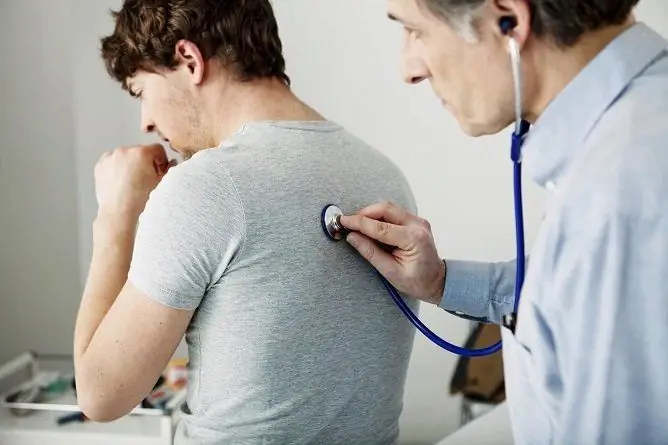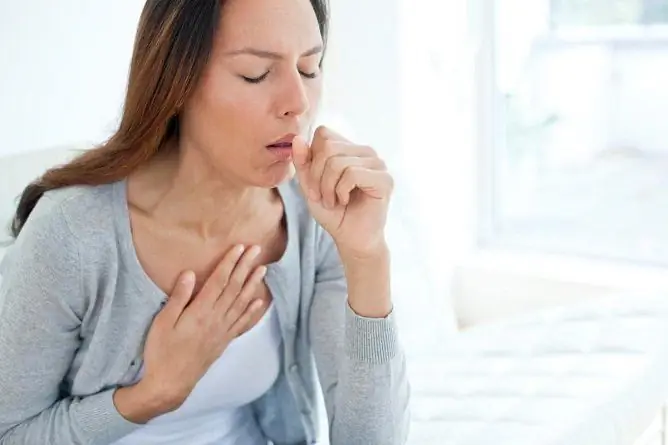- Author Rachel Wainwright [email protected].
- Public 2024-01-15 19:51.
- Last modified 2025-11-02 20:14.
How to treat pneumonia at home in adults and children
The content of the article:
-
The reasons for the development of pathology
Trigger factors
- Lung inflammation symptoms
-
Diagnosis of the disease
- Blood test
- X-ray examination of the lungs
- Other diagnostic methods
- Assessment of the severity of pneumonia
-
Treating pneumonia at home
- General recommendations for organizing treatment at home
- Pregnancy therapy
- Evaluation of the effectiveness of pneumonia treatment at home
- Traditional medicine for pneumonia
- When is hospitalization indicated
- Video
Treatment of pneumonia at home can be carried out only with a mild course of pathology in agreement with the doctor. In most cases, pneumonia requires hospitalization of the patient, as therapy under constant medical supervision is safer and more effective.

Treatment of pneumonia at home should be carried out only under medical supervision.
It should be borne in mind that the course of pathology is possible without fever and severe cough. Therefore, when even mild symptoms appear, it is recommended to seek help from a doctor who can correctly diagnose the existing symptoms and prescribe the desired treatment method.
With the timely initiation of therapy, the prognosis of pneumonia is favorable, while its absence or independent selection of a method of treatment is fraught with the development of irreversible complications, and a lethal outcome is not excluded.
The reasons for the development of pathology
The development of the disease is facilitated by an infection in the lungs, affecting mainly the alveoli and interstitial tissue, and not the respiratory tract. Pathology can be caused by pathogenic microorganisms that enter the lung tissue with the smallest drops of water in the inhaled air, through the circulatory system or from foci of other inflammations in the body. The causative agents of the disease include:
- bacteria - streptococcus, moraxella, staphylococcus, Haemophilus influenzae, pneumococcus;
- protozoa;
- viruses - rhinoviruses, influenza;
- chlamydia;
- fungi - pneumocystis, candida;
- rickettsia.

Pneumococci are common causative agents of pneumonia
In the overwhelming majority of cases, inflammation develops under the influence of bacterial agents. Pathogens are introduced into the air from an infected person through coughing or sneezing. It is extremely rare that a non-infectious form of the disease is recorded, the appearance of which provokes prolonged inhalation of toxic substances and poisons.
Trigger factors
The likelihood of pneumonia increases with the following conditions or diseases:
- chronic diseases of the kidneys, heart, liver, lungs and other organs;
- oncological pathologies;
- weakening of the immune system;
- chest defects (congenital or acquired);
- smoking;
- immunodeficiency;
- stay on a ventilator for a long period;
- forced prolonged lying position;
- infancy and old age (over 60 years old);
- organ transplantation;
- diabetes;
- bronchitis.
Lung inflammation symptoms
The manifestations of the disease differ depending on the degree of lung damage and the type of pathogen. Signs characteristic of all pneumonia are such as:
- a sharp increase in body temperature up to 38-40 ° C;
- dry cough, which eventually becomes moist with a viscous, difficult to separate phlegm;
- soreness in the muscles;
- hyperhidrosis;
- chills;
- headache;
- increased fatigue;
- decreased or lack of appetite;
- weakness;
- chest pain that appears or worsens with coughing or breathing.
Diagnosis of the disease
To confirm the diagnosis, the doctor collects anamnesis, examines the patient and records his complaints. After that, the patient receives a referral for a detailed blood test.
Blood test
The erythrocyte sedimentation rate with pneumonia always exceeds normal values. Moderate leukocytosis and a shift of the leukocyte formula to the left are characteristic of a mild course of pathology, while a pronounced increase in the number of leukocytes indicates an inflammatory process of moderate severity.
In the blood, anemia can also be determined, reflecting prolonged intoxication of the body.
X-ray examination of the lungs
Along with a blood test, an X-ray examination of the lungs is one of the necessary diagnostic measures, which shows whether there are changes in the pulmonary pattern.

X-ray of the lungs is of great diagnostic value
In patients with pneumonia, clear multiple foci of darkening, increased stretching originating from an expanded shadow of the lung root, or a dense reticular pattern with small gaps can be visualized.
Other diagnostic methods
Of particular importance for the selection of effective treatment methods is the identification of the pathogen, and in cases of bacterial infection, the determination of the sensitivity of pathogenic agents to drugs with antibacterial action. For this purpose, microscopic examination of sputum, bronchial lavages and tracheobronchial aspirate, as well as bacterial culture are performed.

To identify the pathogen, bacterial inoculation is carried out
In cases where the cause of inflammation with the use of such studies cannot be identified, the pulmonologist may prescribe a biopsy. During its implementation, through an endoscope, the infected material is taken from the lung.
Assessment of the severity of pneumonia
Assessment of the severity of the pathology is an important criterion for determining the ability to carry out treatment at home.
| Key features | Mild degree | Average degree | Severe degree |
| Temperature | Up to 38 ° С | 38-39 ° C | Above 39 ° C |
| Intoxication | Absent or mild | Moderately expressed | Strongly expressed |
| The presence and nature of complications | Usually absent | Develop infrequently | They are common (in the form of empyema, abscess formation, etc.) |
| Tolerability and effectiveness of treatment | Good tolerance, fast effect | Allergic and toxic reactions are possible | Later effect, frequent adverse reactions |
Treating pneumonia at home
Therapy of pathology, first of all, should be aimed at destroying the pathogenic flora that provoked its development, and not at stopping the symptoms. The patient is prescribed antibiotics, with their regular intake in doses calculated by the doctor, the manifestations of the disease disappear within a few days, and the complete destruction of the infection occurs in 1-2 weeks.
It is important for the patient to undergo a full course of antibiotic therapy, even if the condition improves within a few days from its beginning. Early withdrawal is fraught with relapse and the development of bacterial resistance, in which a repeated course of medication will be useless.
For pneumonia caused by intracellular pathogens or viruses, anti-inflammatory and antiviral drugs are prescribed. These include medicines such as Zanamivir, Arbidol, and Oseltamivir.
In patients with a fungal form of the disease, a specific approach to treatment is required, since most often this type of pneumonia occurs against the background of immunodeficiency. The doctor prescribes a combination of antifungal agents with immune-strengthening drugs.
Expectorants, antipyretics, antitussives or pain relievers (for example, Bromhexine, ACC) can be used as symptomatic therapy.

Massage is often used as a complementary treatment
In addition to conservative methods, measures that promote the healing process may be recommended - physiotherapy exercises, massage and physiological procedures.
General recommendations for organizing treatment at home
Home treatment can be carried out provided that the patient did not suffer from severe infectious pathologies before the inflammation, and the course of pneumonia itself is characterized as mild. It is important to take the drugs prescribed by the pulmonologist in accordance with the prescribed scheme, without exceeding the indicated dosages.

During the acute course of the disease, it is important to observe bed rest
It is worth noting that the treatment of pneumonia at home, especially if the child is sick, involves adherence to bed rest and a sparing diet. A generous intake of warm drink is recommended and, if you have appetite, the use of mild, mild puree-like dishes.
Pregnancy therapy
If pneumonia of a bacterial nature is diagnosed during pregnancy, treatment should be carried out strictly under medical supervision.
Since during this period it is permissible to take far from all medicines, based on the duration of pregnancy and the characteristics of its course, patients are prescribed light antibacterial drugs. These can be drugs with a short duration of admission or alternative herbal medicine.
Evaluation of the effectiveness of pneumonia treatment at home
The effectiveness of the drugs used can be determined by the subsiding of the symptoms of pathology, namely:
- body temperature decreases and does not exceed 37.5 ° C;
- no signs of intoxication;
- purulent sputum gradually leaves and ceases to stand out with a cough;
- manifestations indicating respiratory failure are absent;
- positive dynamics according to the X-ray examination of the lungs.
Traditional medicine for pneumonia
In addition to conservative treatment of pneumonia at home, traditional medicine can be used on the recommendation of a doctor. The most effective of them are such recipes as:
- recipe number 1: pour 2 tbsp into a small container. spoons of oats and the same amount of raisins, pour 1 liter of water and put on low heat. The liquid is boiled until its initial volume is halved. After that, the mixture is thoroughly filtered, slightly cooled and 1 tbsp is added to it. a spoonful of honey. In finished form, the product is taken in 1 tbsp. spoon 4 times a day throughout the entire period of drug therapy;
- recipe number 2: place 1 tbsp in a container. a spoonful of dried raspberries, coltsfoot herbs and oregano, are thoroughly mixed. Then 1 tbsp. pour a spoonful of the resulting collection into a thermos and pour 300 ml of boiling water. The liquid is infused for 45-60 minutes, after which it is filtered. The finished broth is taken orally in small portions during the day;
- recipe number 3: 1 tbsp. a spoonful of aloe juice is mixed with 2 tbsp. spoons of honey and pour 3 tbsp. spoons of vodka. The product is mixed and wrapped in cheesecloth. The finished compress is placed on the chest area every day before bedtime;
- recipe number 4: 40 g of peeled hazelnuts are poured into 500 ml of dry red wine, put on low heat and simmer for 20 minutes. The medicine is taken orally in 1 tbsp. spoon before each meal;
- recipe number 5: 100 g of dried fruits of the viburnum ordinary pour 1 liter of boiling water, put on low heat and cook for 10 minutes. Then filter the broth, cool a little and add 3 tbsp. spoons of honey. The product is drunk warm, half a glass 3 times a day.
When is hospitalization indicated
Concomitant chronic diseases - diabetes mellitus, chronic obstructive pulmonary disease, congestive heart failure, chronic nephritis and hepatitis, substance abuse or alcoholism, immunodeficiency - are risk factors for the development of complications. In such cases, it is recommended to carry out treatment in a hospital setting.

In the presence of risk factors, treatment at home cannot be carried out, and the patient needs hospitalization
Also, hospitalization is indicated in the presence of the following factors:
- ineffective outpatient treatment for three days;
- confusion / decreased consciousness;
- the number of breaths is more than 30 per minute;
- unstable hemodynamics;
- infectious metastases;
- septic shock;
- multi-lobe lesion;
- abscess formation;
- exudative pleurisy;
- leukopenia or leukocytosis;
- renal failure;
- anemia;
- social indications;
- age from 70 years.
Video
We offer for viewing a video on the topic of the article.

Anna Kozlova Medical journalist About the author
Education: Rostov State Medical University, specialty "General Medicine".
Found a mistake in the text? Select it and press Ctrl + Enter.






